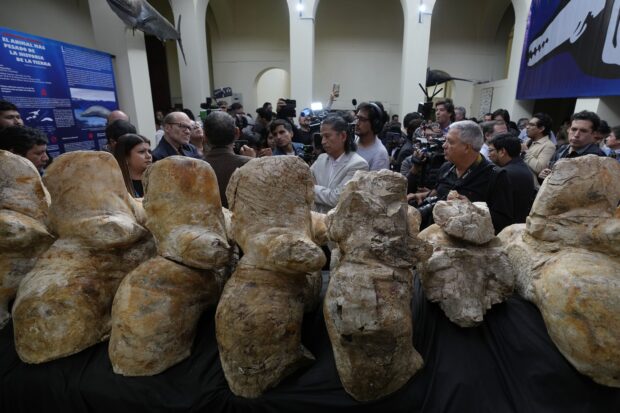Visitors and journalists gathered in Lima, Peru on August 2, 2023, for a presentation showcasing a newly discovered species called Perucetus colossus, also known as “the colossal whale from Peru.” This remarkable finding challenges the long-standing reign of the blue whale as the heaviest animal on record. The fossils of this ancient giant were unearthed by Mario Urbina, a researcher from the University of San Marcos’ Natural History Museum, who stumbled upon them more than ten years ago. With the help of an international team, the fossils were carefully extracted from the Ica desert, a region in Peru that was once submerged and renowned for its abundance of marine fossils.
The study describing the species, published in the journal Nature, reveals fascinating details about Perucetus colossus. Each vertebra of this whale weighs over 220 pounds (100 kilograms), and its ribs measure nearly 5 feet (1.4 meters) in length. Paleontologist Hans Thewissen of Northeast Ohio Medical University, who was not involved in the research, expressed excitement over this extraordinary find, stating that it is truly remarkable to encounter such a colossal animal that is entirely unique.
The excavation yielded 13 vertebrae from the whale’s backbone, four ribs, and a hip bone, providing researchers with a valuable glimpse into the anatomy of this ancient creature. Through the use of 3D scanning technology and careful analysis of the bones, the scientists were able to estimate the size and weight of the whale. Comparing it to modern marine mammals, they determined that Perucetus colossus weighed between 94 and 375 tons (85 and 340 metric tons), potentially surpassing the largest blue whales on record, which weigh around 200 tons (180 metric tons). While the discovered whale’s body measured about 66 feet (20 meters) in length, it falls short of the length of some blue whales, which can exceed 100 feet (30 meters).
One of the most intriguing aspects of this discovery is the density and heaviness of the whale’s bones. These features indicate that Perucetus colossus likely inhabited shallow coastal waters, similar to other marine creatures like manatees, which possess heavy bones to assist in staying close to the seafloor. Without the skull, scientists can only speculate on the whale’s diet and how it sustained its massive body. It is possible that the whale scavenged food from the seafloor or consumed large quantities of krill and other small sea creatures. However, paleontologist Hans Thewissen suggests that the feeding habits of this ancient giant may have been entirely unconventional and unimaginable.
In conclusion, the discovery of Perucetus colossus presents an awe-inspiring glimpse into the ancient past, bringing to light a species that challenges our understanding of marine life. Its colossal size, unique characteristics, and dense bones make it a captivating subject for scientific exploration. The findings from this excavation contribute significant insights into the evolution and diversity of marine mammals throughout history.
Denial of responsibility! VigourTimes is an automatic aggregator of Global media. In each content, the hyperlink to the primary source is specified. All trademarks belong to their rightful owners, and all materials to their authors. For any complaint, please reach us at – [email protected]. We will take necessary action within 24 hours.


